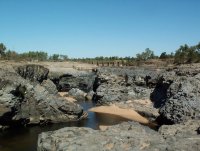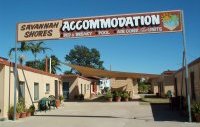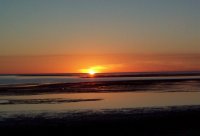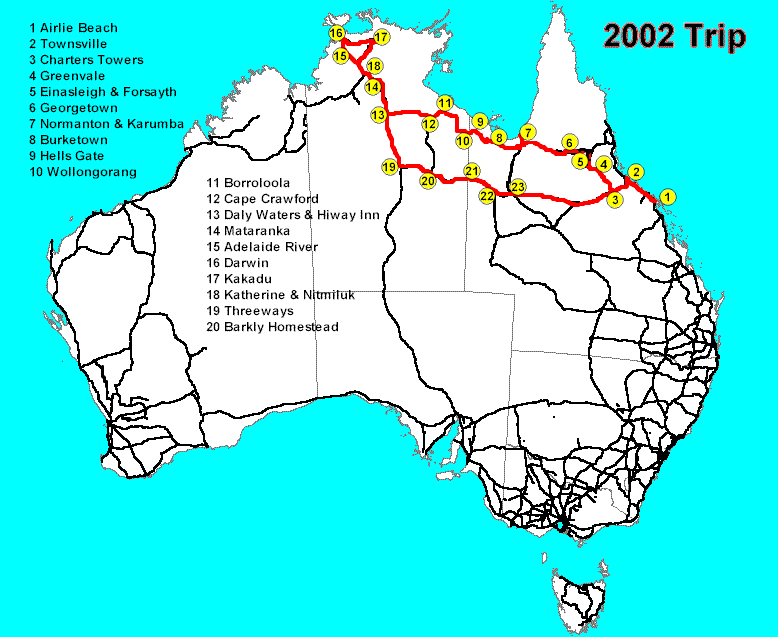An account in 5 parts of our trip in the 4WD motorhome through parts of northern Australia. Part 2 (Karumba to Borroloola), Part 3 (Borroloola to Darwin), Part 4 (Kakadu and Nitmiluk), Part 5 (Katherine and home). Click on a photo to see it full size. Photo album is here.
Note: Some things have changed since we took this trip, so some statements are out of date. We’ve updated many of the links to other information sources, but we haven’t (yet) attempted to add notes on all the other changes.
We set out from Airlie Beach on Monday, 1 July 2002, heading north to the Gulf of Carpentaria on the first leg of a planned trip around Australia. (As you’ll see, we didn’t get anywhere near as far as we intended. The trip started out fine, but as you’ll read in later installments, that changed.)
We stopped for two nights in Townsville to do some necessary personal business, staying in the Townsville Auto Resort and Van Park on Bowen Road near the Ross River. As is typical in cities and larger towns, the sites were small and fairly crowded, but nicely shaded and otherwise quite pleasant. A smaller vehicle would have found it much more convenient than we did, as the site was wide enough for a caravan with awning or extension, with a car alongside. The approach lane was narrow, but we did have space to get in and out without major problems. We were pleased to see they had well designed shower stalls, unlike most van parks. We could get into the central business district (to visit museums or the casino, or catch a ferry to Magnetic Island) using a bus that stopped just outside the entrance once an hour.
Wednesday, 3 July 2002.
We headed inland from Townsville, stopping for a break at the service station (19-41.881S 146-50.392E) about 90 km east of Charters Towers. They have very convenient diesel pumps for larger vehicles (plenty of space to get in and out) and 24-hour service, including showers.
A pleasant-looking free camping site is at the Macrossan Bridge Park, about 25 km east of Charters Towers. There is also a van park nearby.
At Charters Towers we turned north on the Gregory Highway (aka The Jack McEwan Beef Road). On tourist maps, it is often listed as part of The Great Inland Way, reaching from Dubbo in NSW to Cairns on the coast in tropical north Queensland. A sign just outside town said “Narrow road next 246 kilometres” but this turned out to be slightly inaccurate, as the road to The Lynd has been improved considerably since we last drove it two years ago. Much of the road now has two lanes of bitumen (one in each direction) rather than only one lane.
At Fletcher Creek (19-48.866S 146-03.289E), about 50 km north of Charters Towers or 160 km south of Greenvale, we noticed several vans camped, with plenty of space for even big rigs. There was a toilet block, with two cold-water and somewhat primitive showers. This place wasn’t listed in our rest areas book.
Along the way, we saw a kookaburra with a startling expanse of blue feathers, and several large birds with some features of a crane (where’s the bird book when you need it?). In addition to the usual crows, and the kites soaring looking for road kill, we came upon a pair of fine looking eagles on the road. Eric had to brake hard to stop before we reached them (they definitely did not want to leave their meal), and we got a good look at them as they retreated to nearby trees.
We stopped briefly at Bluewater Springs Roadhouse (19-28.742S 145-38.706E), the first and only roadhouse between Charters Towers and Greenvale, where we had some fine chicken and salad sandwiches and milkshakes.
We stopped for the night in Greenvale (19-00.111S 144-58.719E) in the pleasant van park, and ate dinner at the Three Rivers Pub, which served huge and delicious meals in pleasant surroundings. The caravan park had well-designed showers.
The van park had as an ornament an enormous nickel mine reclaimer wheel. Mine machinery typically runs to impressive sizes, and this one came from the 1967 nickel laterite mine that went into production in 1974 and used the now dismantled rail line to Townsville. It took 40 million tonnes of ore out, using 220 mine employees, and closed in 1992.
The town shut down to 16 people when the mine closed, but in 1994 Melbourne businessman Chris Delios saw the town, and the next day offered to buy it from Queensland Nickel Ltd. Greenvale now has about 85 family homes, and is partially reviving by providing local business sites as well as promoting itself as an outback oasis. Considering the small size, it has a good range of facilities: hotel-motel, 3 star van park with powered sites, service station, postal services, sports oval with pool, school, police, a store and bakery, a craft bazaar with pottery, and even a 9-hole golf course. There is a farm homestay at nearby Jervoise Station, which produces organic beef for export and the domestic market.
Thursday 4 July 2002.
Continuing north, we stopped briefly at the BP Oasis service station at Lynd Junction. It had expensive drinks, and the facilities were not startling, but seemed adequate for a bush area. Even non-patrons could use the showers for $3.
 We turned onto a dirt road here, with 73 km to Einasleigh on the eastern edge of the Newcastle Range. We reached the small town (18-30.816S 144-05.554E) at 11:30, after an impressively short and steep drop to the low causeway across the Copperfield River just before the town. The Pub had only meat pies, so we made do with that for lunch (after the previous night’s meal, we didn’t want much).
We turned onto a dirt road here, with 73 km to Einasleigh on the eastern edge of the Newcastle Range. We reached the small town (18-30.816S 144-05.554E) at 11:30, after an impressively short and steep drop to the low causeway across the Copperfield River just before the town. The Pub had only meat pies, so we made do with that for lunch (after the previous night’s meal, we didn’t want much).
The Chillagoe to Forsayth rail line went through the town when the rail was open, and even stopped at the pub. Nowadays the Savannahlander tourist train comes through on its way from Cairns to Forsayth; unfortunately, the rail bridge had been wrecked by floods in February, so the train now has to stop at Einasleigh.
 We walked over to the Copperfield River and Gorge for a look. The contrast between the black rock (granite?) walls and the sandy river bottom is interesting, especially as the black vegetation-free rock extends like a scar over a considerable area around the river near the town.
We walked over to the Copperfield River and Gorge for a look. The contrast between the black rock (granite?) walls and the sandy river bottom is interesting, especially as the black vegetation-free rock extends like a scar over a considerable area around the river near the town.
Later, along the road, we saw another eagle, some small pigs, a very large goanna sunning itself on the road, and numerous wallabies (live, not roadkill this time).
After another 70 km of dirt road over the Newcastle Range, we reached Forsayth on the Delaney River (18-35.240S 143-36.233E). This town of 70 people didn’t have many interesting features, although there were a number of historic buildings. Forsayth seems mainly of interest to gold fossickers, as like many of the towns in north Queensland, it was a gold rush area. More about Forsayth from Savannah Guides.
After a cooling (non-alcoholic) drink at the Goldfields Hotel we continued the remaining 40 km of dirt road to Georgetown. We had stayed there two years ago, but we had difficulty getting our truck into the Midway caravan park (although the food there was good, and it was otherwise a fine place to stay). Fossicking is again the main tourist activity, although there are also restored historical buildings, a free swimming pool, and free internet access at the Tourist Information Centre. More about Georgetown from Savannah Guides.
We were now in the Gulf Savannah area, with the typical golden, sun-dried vegetation of this flat area in the dry season, a change from the Newcastle Ranges, both in vegetation and in having straight roads rather than twisted, steep and narrow roads. The Gulf Savannah region extends from the Great Dividing Range (low hills, in USA terms) west to the Northern Territory border, and consists of mostly untouched bush, sprinkled with the remains of mining towns, many dating from the gold rushes of the 1870’s. Naturally our timing for this trip is designed to avoid the wet summer season of tropical monsoons.
We noticed a shortage of some facilities. The only bank we can find is in Normanton, prescription drugs are basically not available commercially in the region, and TV reception can be haphazard even in the towns. Interestingly, there is Internet access in a number of towns, mostly through either the Council library or the Tourist Information Office. Burketown, Normanton, Karumba, Croydon, and Georgetown all have at least one terminal with web access (when the phones are working).
Croydon is 148 km further on. The road has improved a lot over the past two years, now having two paved lanes over most of it. We made good time, but it was well after 5 before we were settled in the spacious council caravan park at Croydon (18-12.11S 142-14.748E). More about Croydon from Savannah Guides.
Friday 5 July 2002.
Chris Weirman, the local information officer, has a fine Internet setup and does conducted tours of the town.
We passed through Normanton and continued to Karumba (17-27.605S 140-49.680E). Barry and Lorraine’s Karumba Point Tourist Park looked inviting, but they have a really nice range of shade trees (desirable in this climate) that our truck is unlikely to get past without knocking off limbs.
The Sunset caravan park had a couple of spots we could probably get our truck into, despite the trees, but they were all occupied. Considering it is high season, school holidays, and great weather, we hadn’t really expected much luck there.
Our next choice was the Gone Fishin’ motel, because it is directly opposite the Sunset Tavern and has space for us to park in front of the units; we stayed there last time and liked it. Since then, they’ve renovated their units, which now look particularly inviting. Unfortunately, they had no vacancies.
 Carol at Gone Fishin’ suggested we try Savannah Shores, the next place along. Margaret and Bill had one room still available, somewhat more primitive (no unsuite, but good beds and a small kitchen; quite acceptable for us. They also have new ensuite cabins, but all were booked. You can contact them at PO Box 49, Karumba 4891, phone (07) 4745 9126, fax (07) 4745 9077. No e-mail address.
Carol at Gone Fishin’ suggested we try Savannah Shores, the next place along. Margaret and Bill had one room still available, somewhat more primitive (no unsuite, but good beds and a small kitchen; quite acceptable for us. They also have new ensuite cabins, but all were booked. You can contact them at PO Box 49, Karumba 4891, phone (07) 4745 9126, fax (07) 4745 9077. No e-mail address.
 Finally it was time to visit the Sunset Tavern. Beers in hand, we awaited the sunset over the sea. It wasn’t quite as dramatic as last time, as no cloud banks were in the area, and the tide was out, so the pelicans weren’t prowling the shoreline, but we enjoyed it very much anyway. We also enjoyed our grilled barramundi dinner; Gulf barra is even tastier than the species we get back home, and that’s darn good eating too.
Finally it was time to visit the Sunset Tavern. Beers in hand, we awaited the sunset over the sea. It wasn’t quite as dramatic as last time, as no cloud banks were in the area, and the tide was out, so the pelicans weren’t prowling the shoreline, but we enjoyed it very much anyway. We also enjoyed our grilled barramundi dinner; Gulf barra is even tastier than the species we get back home, and that’s darn good eating too.
We stayed three nights in Karumba, taking a few walks in the comfortable temperatures of early winter (though the sun is fiercely bright even at this season), lazing around reading a book or catching up on our writing, consuming beer and barra, and otherwise just goofing off.
Next installment: across the Great Top Road (Savannah Way) to Borroloola by way of Burketown, Hells Gate, and Wollogorang.
For more information about places mentioned
Two good sites for more information about the places mentioned in this newsletter are Travelmate and Walkabout.
If you’re interested in reading about our trip though this area in 2000, and more about the area itself, it’s here and here.

